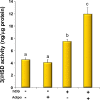Activation of the LH receptor up regulates the type 2 adiponectin receptor in human granulosa cells
- PMID: 23779096
- PMCID: PMC3725221
- DOI: 10.1007/s10815-013-0012-3
Activation of the LH receptor up regulates the type 2 adiponectin receptor in human granulosa cells
Abstract
Purpose: Adiponectin is a predominantly adipocyte-derived hormone which influences insulin sensitivity and energy homeostasis through at least two receptors, AdipoR1 and AdipoR2. In animal models, adiponectin may regulate ovarian steroidogenesis, folliculogenesis, and ovulation. The receptors AdipoR1 and AdipoR2 are present in the human ovary, but their regulation is unknown. In these studies, we determined the effects of LH receptor activation on the expression and function of the two adiponectin receptors in human granulosa cells.
Methods: Granulosa cells were obtained at the time of oocyte retrieval in women undergoing in vitro fertilization (IVF). Cells were isolated and cultured for 48 h in DMEM/F12 medium with 5 % FBS and 50 ug/ml gentamicin. Medium was changed to low serum for 12 h and cells were treated with hCG (100 ng/ml), forskolin (30 μMol/L), or FSH (1 IU/ml) for 24 h for mRNA experiments. mRNA was isolated and RT PCR was performed using Taqman assays and quantification with the delta delta CT method. For immunocytochemistry, cells were grown on chamber slides and treated with hCG for 1 to 24 h and fixed with acetone. ICC was performed with polyclonal rabbit primary antibodies followed by alexa fluor goat anti-rabbit antibody and imaging with a fluorescence microscope and Zeiss software analysis. 3β-hydroxysteroid dehydrogenase (3βHSD) enzyme activity was determined by measuring the progesterone produced when cells were provided with an excess of 22-hydroxy-cholesterol as substrate following an incubation with hCG (1 IU/ml) and/or adiponectin (10 ng/ml). Progesterone content in the media was determined by ELISA.
Results: Messenger RNA for the two Adiponectin receptors is differentially regulated by activation of LHR with hCG treatment. AdipoR2 was increased nearly 4-fold (p < 0.05), whereas AdipoR1 expression was not changed by hCG treatment. Treatment with either FSH or forskolin (an activator of cAMP) had similar effects. Basal AdipoR2 protein was fairly low in granulosa cells in culture however treatment of cells with hCG resulted in a discernible increase in immunodetectable cytoplasmic protein as early as 6 h after treatment and was maintained for at least 24 h. The number of cells positive for AdipoR2 at 6 h increased from a basal of 20 % to almost 60 % (p < 0.05). Adiponectin treatment of hCG-primed cells resulted in increased 3βHSD activity by approximately 60 % over hCG alone and more than 3-fold over basal levels.
Conclusions: AdipoR2 is regulated by the LH receptor function via a cAMP dependant mechanism. Increased expression of adipoR2 prior to and following ovulation may contribute to enhanced 3βHSD activity and increased progesterone secretion by the corpus luteum of the ovary. Dysregulation of adiponectin that may occur with PCOS may impair normal progesterone production.
Figures




Similar articles
-
Regulation of adiponectin and its receptors in rat ovary by human chorionic gonadotrophin treatment and potential involvement of adiponectin in granulosa cell steroidogenesis.Reproduction. 2007 Apr;133(4):719-31. doi: 10.1530/REP-06-0244. Reproduction. 2007. PMID: 17504916
-
Downregulation of adiponectin system in granulosa cells and low levels of HMW adiponectin in PCOS.J Assist Reprod Genet. 2016 Jan;33(1):101-10. doi: 10.1007/s10815-015-0620-1. Epub 2015 Dec 2. J Assist Reprod Genet. 2016. PMID: 26631404 Free PMC article.
-
Adiponectin increases insulin-like growth factor I-induced progesterone and estradiol secretion in human granulosa cells.Fertil Steril. 2009 Dec;92(6):1988-96. doi: 10.1016/j.fertnstert.2008.09.008. Epub 2008 Dec 10. Fertil Steril. 2009. PMID: 19081562
-
ERβ Regulation of Gonadotropin Responses during Folliculogenesis.Int J Mol Sci. 2021 Sep 26;22(19):10348. doi: 10.3390/ijms221910348. Int J Mol Sci. 2021. PMID: 34638689 Free PMC article. Review.
-
Expression and localization of adiponectin in myoepithelial cells in sublingual glands of normal and diabetic rats.J Oral Biosci. 2025 Mar;67(1):100590. doi: 10.1016/j.job.2024.100590. Epub 2024 Nov 28. J Oral Biosci. 2025. PMID: 39613095 Review.
Cited by
-
Short communication: Photoperiod impacts ovarian extracellular matrix and metabolic gene expression in Siberian hamsters.Comp Biochem Physiol A Mol Integr Physiol. 2022 Dec;274:111302. doi: 10.1016/j.cbpa.2022.111302. Epub 2022 Aug 27. Comp Biochem Physiol A Mol Integr Physiol. 2022. PMID: 36041709 Free PMC article.
-
Ovarian Transcriptomic Analysis Reveals Differential Expression Genes Associated with Cell Death Process after Selection for Ovulation Rate in Rabbits.Animals (Basel). 2020 Oct 20;10(10):1924. doi: 10.3390/ani10101924. Animals (Basel). 2020. PMID: 33092110 Free PMC article.
-
Chicken Is a Useful Model to Investigate the Role of Adipokines in Metabolic and Reproductive Diseases.Int J Endocrinol. 2018 Jun 19;2018:4579734. doi: 10.1155/2018/4579734. eCollection 2018. Int J Endocrinol. 2018. PMID: 30018639 Free PMC article. Review.
-
Expression profiling of lipocalin-2 and 24p3 receptor in murine gonads at different developmental stages.Exp Ther Med. 2018 Jul;16(1):213-221. doi: 10.3892/etm.2018.6196. Epub 2018 May 18. Exp Ther Med. 2018. PMID: 29896242 Free PMC article.
-
Metabolic hormones are integral regulators of female reproductive health and function.Biosci Rep. 2024 Jan 31;44(1):BSR20231916. doi: 10.1042/BSR20231916. Biosci Rep. 2024. PMID: 38131197 Free PMC article. Review.
References
-
- Chaudhuri C, Harada Y, Shimizu K, Gut M, Dorfman RI. Biosynthesis of Pregnenolone from 22-Hydroxycholesterol. J Biol Chem. 1962;237(3):703–5. - PubMed
MeSH terms
Substances
Grants and funding
LinkOut - more resources
Full Text Sources
Other Literature Sources
Miscellaneous

